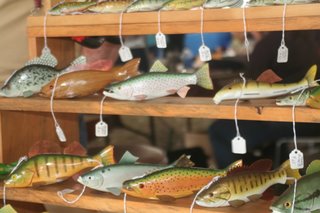 Have you ever heard of a fish decoy? I hadn't until I came across them at the show on Saturday. Sheepishly I asked the gentleman selling them if they were just decorative or if they actually had some use. He explained that yes, some people collect them, but in places where spear fishing is allowed these decoys are used to lure bigger fish to a hole made in the ice of a frozen lake. Lines are attached to the decoy, then to a stick or *jig* and the decoy is made to swim in a way so as to attract other fish that can be speared from above the ice. Like duck decoys, fish decoys are quite popular as folk art, in addition to their more practical use. Who'd have guessed it? Me, I just thought it was pretty. It's a Lake Trout, carved from white pine and only 8" long with a beautiful curve to its body. It's surprisingly heavy for its size, due to the weights placed in its belly to make it *swim* properly. The carver suggested I try it out in the bathtub to see how it works.
Have you ever heard of a fish decoy? I hadn't until I came across them at the show on Saturday. Sheepishly I asked the gentleman selling them if they were just decorative or if they actually had some use. He explained that yes, some people collect them, but in places where spear fishing is allowed these decoys are used to lure bigger fish to a hole made in the ice of a frozen lake. Lines are attached to the decoy, then to a stick or *jig* and the decoy is made to swim in a way so as to attract other fish that can be speared from above the ice. Like duck decoys, fish decoys are quite popular as folk art, in addition to their more practical use. Who'd have guessed it? Me, I just thought it was pretty. It's a Lake Trout, carved from white pine and only 8" long with a beautiful curve to its body. It's surprisingly heavy for its size, due to the weights placed in its belly to make it *swim* properly. The carver suggested I try it out in the bathtub to see how it works. I had a hard time choosing which I liked best, but think I chose a good one. The artist, Rich Brooks, has won many awards for his decoys and lures and the one I chose was featured in a display this summer at the Tuckerton Seaport where he was the *artist in residence*. A nice pic of my decoy is available here and more info about fish decoys in general is available at this website.
I had a hard time choosing which I liked best, but think I chose a good one. The artist, Rich Brooks, has won many awards for his decoys and lures and the one I chose was featured in a display this summer at the Tuckerton Seaport where he was the *artist in residence*. A nice pic of my decoy is available here and more info about fish decoys in general is available at this website.What I love most about the decoy show is the chance to chat with the people who make such beautiful things. They all seem to love to talk and share their expertise. I'd imagine it's difficult on the ego to set up a booth filled with things you've worked hundreds of hours on and poured your soul into, only to see so many people pass by without much more than a glance. Those of us that do stop to ask questions (and to buy) are richly rewarded with a peek into the heart of an artist. Each decoy I own has been bought this way, after the telling of a story or a conversation about some aspect of their craft. That personal connection is what makes each decoy unique and special to me.


11 comments:
Interesting! I never knew about fish decoy. I'll have to ask my fishing friends if they know about these. Thanks for sharing!
Huh! Never knew they existed!
They really are pretty. And you are right about how hard it must be to sell something you made with your two hands.
Thank goodness for artists!
(Like Julie Zickefoose....here is your big LOUD reminder...go order one, girl!)
That is a lovely decoy. I think it's neat that you have a story behind your decoys. It is amazing the amount of work that goes into such things - my old boss used to make handmade fly fishing lures, it was amazing to watch him work on them, I would never have such patience.
Hm. I never knew these existed, either. Thanks for the interesting post.
I have seen them on The Antiques Roadshow. But, never in real life.
They are great pieces of art.
Should have mentioned in my post that spear fishing is only allowed in Minnesota, Wisconsin, and Michigan. At least I think that's correct. I'm curious about why it's only allowed in those places - maybe someone knows?
I've never heard of a fish decoy. Thanks for giving us the story--and as you said, "a peek into the heart of an artist." I'm sure they felt your warmth.
I'm another who's learned something today. Never heard of that before!
You're right about setting up a booth and having people walk by, or far worse, call the goods down right there in front of the vendor.
Great post! Your questions inspired me to do a bit of research on darkhouse spearing. My thoughts are that MN, WI, and MI, with their large numbers of lakes and cold winters, had the biggest tradition of spearing. The numbers of spearers have gone down over the last half-century, probably due to the increased urbanization of society. At the same time, fish populations and average sizes were declining in heavily-fished lakes. "Conventional" anglers blamed spearing for the loss of big fish in lakes, and perhaps in states where there were fewer spearers it was easy to impose spearing bans. However, the tradition of spearing remained strong enough in MN, WI and MI that any attempts to ban the sport have been unsuccessful. It's still controversial in some areas.
Studies I have read show that spearers account for a very small proportion of northern pike harvested on lakes in this area. The spearers I know of are more interested in watching fish than they are in actually spearing them, although they will take home a medium-sized pike or two for dinner.
Personally, I'm all for a fishing method with such a rich tradition, that requires more skill than modern fishing with all its gadgets. I'd like to start collecting decoys myself.
They are too pretty to use, better to collect. But then, I think the same about duck decoys.
Deb: I responded to your comment via email, but have to laugh at the idea of fish-watching. I imagine a fisherman, in the freezing cold, standing over a hole in the ice to see what swims by his decoy. Is that the way that it is?
Sandy: I agree, but the art that is decoy-making stemmed from its more practical uses. I read that fish decoys became most popular during the depression years, of course the natice americans used decoys for hunting also, but from there it has evolved into popular folk art.
Thanks, Laura. I hadn't really thought of fish as pretty, but these decoys do make them so.
Post a Comment